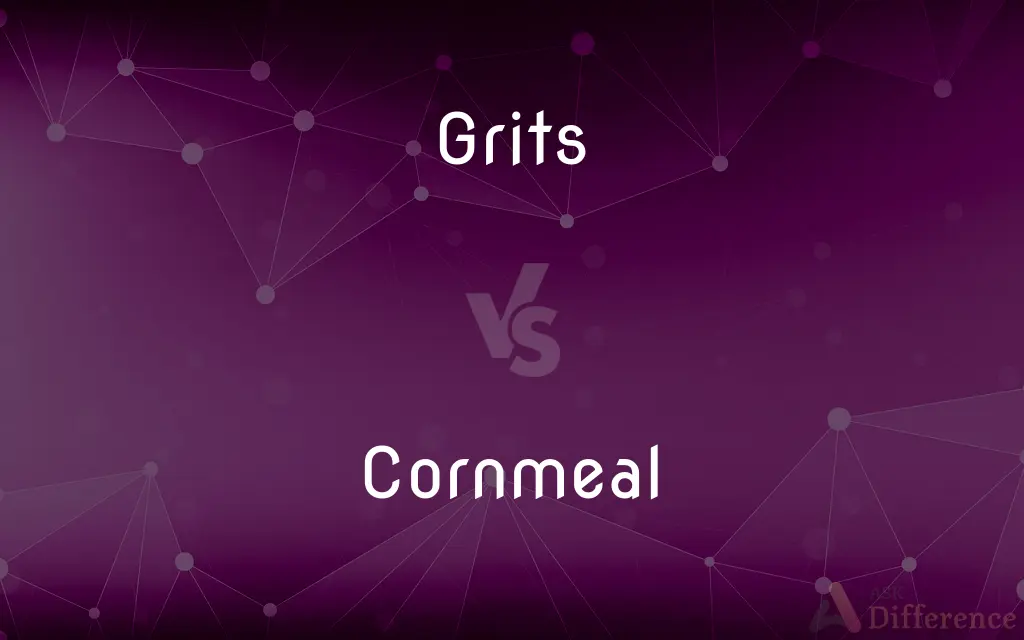Grits vs. Cornmeal — What's the Difference?
By Tayyaba Rehman — Updated on September 19, 2023
Grits are made from dried, ground corn, usually hominy, that's boiled and often served as a side dish. Cornmeal is ground dried corn used mainly for baking. While grits are coarser and often boiled, cornmeal is finer and used as an ingredient.

Difference Between Grits and Cornmeal
Table of Contents
ADVERTISEMENT
Key Differences
Grits are made by grinding corn, specifically hominy, into a coarser texture and are usually boiled in water or milk for consumption. Cornmeal, on the other hand, is finely ground dried corn and is primarily used as an ingredient in recipes such as cornbread or tortillas. Both are derived from corn, but they differ in texture, preparation, and use.
In the kitchen, grits are usually prepared as a hot cereal or side dish, often served with butter, cheese, or gravy. Cornmeal serves a different function, typically acting as a dry ingredient in baked goods or as a coating for fried foods. You might see grits on the breakfast table, but cornmeal is more likely to appear in your cornbread or muffins.
From a grammatical standpoint, "grits" is usually used as a plural noun in American English, as in "a bowl of grits." "Cornmeal" is a mass noun and doesn't have a plural form, such as in "a bag of cornmeal." Despite their differences, both terms originate from the same source, which is corn, and they serve as staple foods in various cuisines.
Grits are often associated with Southern U.S. cooking and can be found on menus as shrimp and grits or cheese grits. Cornmeal has a broader range of uses and can be found in different world cuisines, from Italian polenta to African ugali. Though both are versatile, their specific uses and cultural associations differ significantly.
Comparison Chart
Texture
Coarser
Finer
ADVERTISEMENT
Main Use
Hot cereal or side dish
Ingredient in baking
Preparation
Boiled
Baked or fried
Grammatical Use
Plural noun ("a bowl of grits")
Mass noun ("a bag of cornmeal")
Cultural Association
Southern U.S.
Diverse cuisines
Compare with Definitions
Grits
A coarsely ground corn dish often boiled in water or milk.
She prepared a bowl of grits for breakfast.
Cornmeal
A finely ground flour made from dried corn.
She used cornmeal to make the cornbread.
Grits
A dish often served with various toppings like cheese, gravy, or shrimp.
She enjoys her grits with a splash of hot sauce.
Cornmeal
An ingredient used in different world cuisines.
Cornmeal is the base for Italian polenta.
Grits
A Southern U.S. staple made from hominy.
In the South, grits are a comfort food.
Cornmeal
A baking ingredient used in various recipes.
The pizza crust is made of cornmeal.
Grits
A hot cereal made from ground corn.
He likes his grits topped with cheese.
Cornmeal
A dry powder used for coatings in frying.
She coated the fish in cornmeal before frying.
Grits
A versatile side dish made from ground corn.
The shrimp and grits were the highlight of the meal.
Cornmeal
A versatile kitchen staple made from corn.
He thickened the soup with some cornmeal.
Grits
Grits is a porridge made from boiled cornmeal. Hominy grits is a type of grits made from hominy – corn that has been treated with an alkali in a process called nixtamalization, with the pericarp removed.
Cornmeal
Cornmeal is a meal (coarse flour) ground from dried corn. It is a common staple food, and is ground to coarse, medium, and fine consistencies, but not as fine as wheat flour.
Grits
A dish of coarsely ground maize kernels boiled with water or milk.
Cornmeal
Meal made from corn, used in a wide variety of foods. Also called Indian meal.
Grits
Plural of grit('hulled oats')
Cornmeal
Dried corn (maize) milled (ground) to a coarse meal.
She made a kind of polenta from cornmeal and chicken broth, with some cheese sprinkled on top.
Grits
(Western Hemisphere) Coarsely ground hominy which is boiled and eaten, primarily in the Southern United States.
Cornmeal
Coarsely ground corn
Grits
Plural of grit
Grits
Coarsely ground hulled corn boiled as a breakfast dish in the southern United States
Common Curiosities
Can I use Grits in place of Cornmeal in recipes?
They are not interchangeable due to different textures and uses; it's best to stick with the ingredient specified in the recipe.
How are Grits prepared?
Grits are typically boiled in water or milk and often served as a side dish.
How are Grits different from Cornmeal?
Grits are coarser and usually boiled, while cornmeal is finer and used mainly for baking.
Is Cornmeal a plural noun?
Cornmeal is a mass noun and doesn't have a plural form.
What are Grits?
Grits are a coarsely ground corn dish often boiled in water or milk.
How is Cornmeal used?
Cornmeal is often used as a dry ingredient in baking or as a coating for frying.
What is Cornmeal?
Cornmeal is a finely ground flour made from dried corn.
What is the primary ingredient in Grits?
The primary ingredient in grits is usually hominy, which is treated corn.
Are Grits only a Southern dish?
Grits are most commonly associated with Southern U.S. cuisine but are enjoyed elsewhere as well.
Is Cornmeal used in international cuisines?
Yes, cornmeal is used in a variety of world cuisines, including Italian and African cooking.
Can I make Grits from Cornmeal?
It's not recommended as the texture and cooking times are different, resulting in a dish that doesn't have the desired consistency.
Is Grits a plural noun?
In American English, "grits" is usually used as a plural noun, such as "a bowl of grits."
Do Grits have different flavors?
Grits are often flavored with toppings like cheese, gravy, or shrimp.
Is Cornmeal used in desserts?
Cornmeal can be used in various recipes, including some types of desserts like cornmeal cake.
What is the primary ingredient in Cornmeal?
The primary ingredient in cornmeal is dried corn.
Share Your Discovery

Previous Comparison
Melony vs. Melons
Next Comparison
Ab vs. AbsAuthor Spotlight
Written by
Tayyaba RehmanTayyaba Rehman is a distinguished writer, currently serving as a primary contributor to askdifference.com. As a researcher in semantics and etymology, Tayyaba's passion for the complexity of languages and their distinctions has found a perfect home on the platform. Tayyaba delves into the intricacies of language, distinguishing between commonly confused words and phrases, thereby providing clarity for readers worldwide.














































